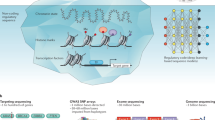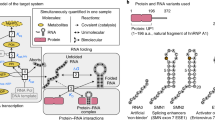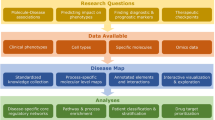Abstract
The molecular biology revolution led to an intense focus on the study of interactions between DNA, RNA and protein biosynthesis in order to develop a more comprehensive understanding of the cell. One consequence of this focus was a reduced attention to whole-system physiology, making it difficult to link molecular biology to clinical medicine. Equipped with the tools emerging from the genomics revolution, we are now in a position to link molecular states to physiological ones through the reverse engineering of molecular networks that sense DNA and environmental perturbations and, as a result, drive variations in physiological states associated with disease.
This is a preview of subscription content, access via your institution
Access options
Subscribe to this journal
Receive 51 print issues and online access
$199.00 per year
only $3.90 per issue
Buy this article
- Purchase on Springer Link
- Instant access to full article PDF
Prices may be subject to local taxes which are calculated during checkout


Similar content being viewed by others
References
McKusick, V. A. Mendelian Inheritance in Man: A Catalog of Human Genes and Genetic Disorders (Johns Hopkins Univ. Press, 1998).
Chen, Y. et al. Variations in DNA elucidate molecular networks that cause disease. Nature 452, 429–435 (2008). This paper was the first demonstration that coherent networks of genes respond to genetic and environmental perturbations and in turn influence disease-associated traits, directly showing that common forms of disease are probably emergent properties of networks rather than the result of single gene changes.
Altshuler, D., Daly, M. J. & Lander, E. S. Genetic mapping in human disease. Science 322, 881–888 (2008).
Barrett, J. C. et al. Genome-wide association defines more than 30 distinct susceptibility loci for Crohn's disease. Nature Genet. 40, 955–962 (2008).
Zeggini, E. et al. Meta-analysis of genome-wide association data and large-scale replication identifies additional susceptibility loci for type 2 diabetes. Nature Genet. 40, 638–645 (2008).
Kathiresan, S. et al. Six new loci associated with blood low-density lipoprotein cholesterol, high-density lipoprotein cholesterol or triglycerides in humans. Nature Genet. 40, 189–197 (2008).
Willer, C. J. et al. Newly identified loci that influence lipid concentrations and risk of coronary artery disease. Nature Genet. 40, 161–169 (2008).
Haiman, C. A. et al. A common genetic risk factor for colorectal and prostate cancer. Nature Genet. 39, 954–956 (2007).
Haiman, C. A. et al. Multiple regions within 8q24 independently affect risk for prostate cancer. Nature Genet. 39, 638–644 (2007).
Li, M. et al. CFH haplotypes without the Y402H coding variant show strong association with susceptibility to age-related macular degeneration. Nature Genet. 38, 1049–1054 (2006).
Maller, J. et al. Common variation in three genes, including a noncoding variant in CFH, strongly influences risk of age-related macular degeneration. Nature Genet. 38, 1055–1059 (2006).
Thorleifsson, G. et al. Genome-wide association yields new sequence variants at seven loci that associate with measures of obesity. Nature Genet. 41, 18–24 (2009).
Emilsson, V. et al. Genetics of gene expression and its effect on disease. Nature 452, 423–428 (2008). This paper is a confirmation in a human population that common diseases like obesity are the result of complex molecular networks responding to genetic and environmental perturbations.
Schadt, E. E. et al. Mapping the genetic architecture of gene expression in human liver. PLoS Biol. 6, e107 (2008).
Lum, P. Y., Derry, J. M. & Schadt, E. E. Integrative genomics and drug development. Pharmacogenomics 10, 203–212 (2009).
Schadt, E. E., Friend, S. H. & Shaywitz, D. A. A network view of disease and compound screening. Nature Rev. Drug Discov. 8, 286–295 (2009).
Goldstein, D. B. Common genetic variation and human traits. N. Engl. J. Med. 360, 1696–1698 (2009).
Hardy, J. & Singleton, A. Genomewide association studies and human disease. N. Engl. J. Med. 360, 1759–1768 (2009).
Kraft, P. & Hunter, D. J. Genetic risk prediction — are we there yet? N. Engl. J. Med. 360, 1701–1703 (2009).
Moffatt, M. F. et al. Genetic variants regulating ORMDL3 expression contribute to the risk of childhood asthma. Nature 448, 470–473 (2007). This was among the first studies to identify a disease-susceptibility gene by restricting attention to DNA variants that simultaneously associate with the disease and the expression levels of genes in the neighbourhood of the disease-associated variant.
Schadt, E. E. et al. An integrative genomics approach to infer causal associations between gene expression and disease. Nature Genet. 37, 710–717 (2005). This was the first study to demonstrate that causal relationships between molecular-profiling traits (such as gene expression) and disease traits could be systematically inferred by integrating these data with genotypic data in human and experimental populations.
Schadt, E. E. et al. Genetics of gene expression surveyed in maize, mouse and man. Nature 422, 297–302 (2003).
Monks, S. A. et al. Genetic inheritance of gene expression in human cell lines. Am. J. Hum. Genet. 75, 1094–1105 (2004).
Morley, M. et al. Genetic analysis of genome-wide variation in human gene expression. Nature 430, 743–747 (2004).
Foss, E. J. et al. Genetic basis of proteome variation in yeast. Nature Genet. 39, 1369–1375 (2007).
Fraser, H. B. & Xie, X. Common polymorphic transcript variation in human disease. Genome Res. 19, 567–575 (2009).
Smirnov, D. A., Morley, M., Shin, E., Spielman, R. S. & Cheung, V. G. Genetic analysis of radiation-induced changes in human gene expression. Nature 459, 587–591 (2009).
Mehrabian, M. et al. Integrating genotypic and expression data in a segregating mouse population to identify 5-lipoxygenase as a susceptibility gene for obesity and bone traits. Nature Genet. 37, 1224–1233 (2005).
Yang, X. et al. Validation of candidate causal genes for abdominal obesity that affect shared metabolic pathways and networks. Nature Genet. 41, 415–423 (2009).
Goldstein, D. B. Genomics and biology come together to fight HIV. PLoS Biol. 6, e76 (2008).
Jones, S. et al. Core signaling pathways in human pancreatic cancers revealed by global genomic analyses. Science 321, 1801–1806 (2008).
Parsons, D. W. et al. An integrated genomic analysis of human glioblastoma multiforme. Science 321, 1807–1812 (2008).
Zhu, J. et al. Integrating large-scale functional genomic data to dissect the complexity of yeast regulatory networks. Nature Genet. 40, 854–861 (2008). This paper generalizes the early idea of integrating gene expression and DNA-variation data to infer causal relationships among gene expression traits and between gene expression and disease traits by integrating diverse types of data, including genotype, gene expression, protein-interaction and DNA–protein-binding data.
Keller, M. P. et al. A gene expression network model of type 2 diabetes links cell cycle regulation in islets with diabetes susceptibility. Genome Res. 18, 706–716 (2008).
Meng, H. et al. Identification of Abcc6 as the major causal gene for dystrophic cardiac calcification in mice through integrative genomics. Proc. Natl Acad. Sci. USA 104, 4530–4535 (2007).
Ghazalpour, A. et al. Genomic analysis of metabolic pathway gene expression in mice. Genome Biol. 6, R59 (2005).
Ghazalpour, A. et al. Integrating genetic and network analysis to characterize genes related to mouse weight. PLoS Genet. 2, e130 (2006).
Zhu, J. et al. An integrative genomics approach to the reconstruction of gene networks in segregating populations. Cytogenet. Genome Res. 105, 363–374 (2004).
Rual, J. F. et al. Towards a proteome-scale map of the human protein–protein interaction network. Nature 437, 1173–1178 (2005).
Han, J. D. et al. Evidence for dynamically organized modularity in the yeast protein–protein interaction network. Nature 430, 88–93 (2004).
Gargalovic, P. S. et al. Identification of inflammatory gene modules based on variations of human endothelial cell responses to oxidized lipids. Proc. Natl Acad. Sci. USA 103, 12741–12746 (2006).
Dobrin, R. et al. Multi-tissue coexpression networks reveal unexpected subnetworks associated with disease. Genome Biol. 10, R55 (2009).
Pe'er, D., Regev, A., Elidan, G. & Friedman, N. Inferring subnetworks from perturbed expression profiles. Bioinformatics 17 (suppl. 1), S215–S224 (2001).
Zhu, J. et al. Increasing the power to detect causal associations by combining genotypic and expression data in segregating populations. PLOS Comput. Biol. 3, e69 (2007).
Schadt, E. E., Sachs, A. & Friend, S. Embracing complexity, inching closer to reality. Sci. STKE 2005, pe40 (2005).
Zeyda, M. & Stulnig, T. M. Adipose tissue macrophages. Immunol. Lett. 112, 61–67 (2007).
Eid, J. et al. Real-time DNA sequencing from single polymerase molecules. Science 323, 133–138 (2009).
Cokus, S. J. et al. Shotgun bisulphite sequencing of the Arabidopsis genome reveals DNA methylation patterning. Nature 452, 215–219 (2008).
Wang, Z., Gerstein, M. & Snyder, M. RNA-Seq: a revolutionary tool for transcriptomics. Nature Rev. Genet. 10, 57–63 (2009).
Ingolia, N. T., Ghaemmaghami, S., Newman, J. R. & Weissman, J. S. Genome-wide analysis in vivo of translation with nucleotide resolution using ribosome profiling. Science 324, 218–223 (2009).
Morgan, T. M., Krumholz, H. M., Lifton, R. P. & Spertus, J. A. Nonvalidation of reported genetic risk factors for acute coronary syndrome in a large-scale replication study. J. Am. Med. Assoc. 297, 1551–1561 (2007).
Stolovitsky, G. & Califano, A. (eds). Reverse Engineering Biological Networks: Opportunities and Challenges in Computational Methods for Pathway Inference (Wiley, 2007).
Schmidt, M. & Lipson, H. Distilling free-form natural laws from experimental data. Science 324, 81–85 (2009).
Bock, G. & Goode, J. A. (eds). 'In Silico' Simulation of Biological Processes 91–103; 119–128; 244–252 (Wiley, 2002).
Author information
Authors and Affiliations
Ethics declarations
Competing interests
E.E.S. was recently employed by, and owns stock in, Merck & Co. At present, he is chief scientific officer of Pacific Biosciences.
Additional information
Reprints and permissions information is available at http://www.nature.com/reprints.
Correspondence should be addressed to E.E.S. (eschadt@pacificbiosciences.com).
Rights and permissions
About this article
Cite this article
Schadt, E. Molecular networks as sensors and drivers of common human diseases. Nature 461, 218–223 (2009). https://doi.org/10.1038/nature08454
Published:
Issue Date:
DOI: https://doi.org/10.1038/nature08454
This article is cited by
-
Web-based multi-omics integration using the Analyst software suite
Nature Protocols (2024)
-
Differential network analysis between sex of the genes related to comorbidities of type 2 mellitus diabetes
Applied Network Science (2023)
-
Detect the early-warning signals of diseases based on signaling pathway perturbations on a single sample
BMC Bioinformatics (2022)
-
Using machine learning to identify gene interaction networks associated with breast cancer
BMC Cancer (2022)
-
Multi-omics peripheral and core regions of cancer
npj Systems Biology and Applications (2022)
Comments
By submitting a comment you agree to abide by our Terms and Community Guidelines. If you find something abusive or that does not comply with our terms or guidelines please flag it as inappropriate.



